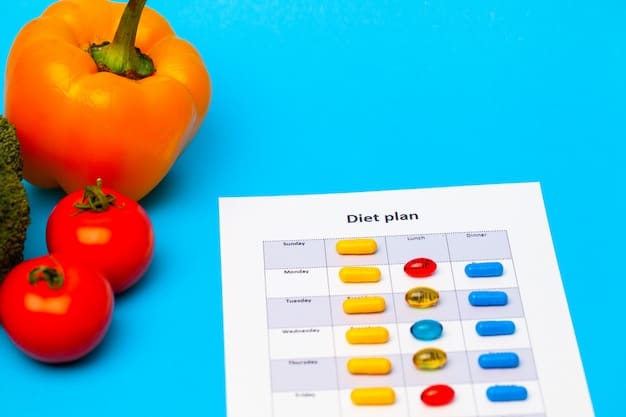The 7-Day Shred: Rapid Weight Loss for Bodybuilders

The 7-Day Shred is a specialized, intensive nutrition plan designed for bodybuilders aiming for rapid weight loss and enhanced muscle definition, primarily achieved through strategic caloric restriction and macronutrient manipulation over a short, focused period to prepare for competitions or peak conditioning.
Embarking on a journey to achieve peak physical conditioning often involves meticulous planning, especially when it comes to nutrition. Among the myriad of dietary strategies, The 7-Day Shred: A Rapid Weight Loss Nutrition Plan for Bodybuilders stands out as a highly specialized approach. This intensive program is explicitly designed for bodybuilders and fitness enthusiasts who need to shed water weight and residual fat quickly, typically in preparation for a competition, photoshoot, or a defined personal goal. It’s a demanding regimen that requires precision, discipline, and a thorough understanding of its mechanisms, aiming to maximize leanness while preserving hard-earned muscle mass.
Understanding the 7-Day Shred Philosophy
The 7-Day Shred is not a sustainable long-term diet, but rather a short-burst, aggressive protocol designed for very specific, short-term goals. Its core philosophy revolves around a significant caloric deficit, precise macronutrient manipulation, and strategic hydration tactics. This plan aims to deplete glycogen stores, reduce subcutaneous water retention, and tap into fat reserves, creating a more “shredded” and defined physique.
It’s crucial to approach this plan with caution and, ideally, under the guidance of a nutrition expert or coach. The intensity of the diet can impact energy levels, mood, and even metabolism if not executed correctly. The overall goal is to maximize aesthetic output for an event without compromising muscle tissue to an unhealthy degree.
Core Principles of the Shred
- Strategic macronutrient reduction: Primarily focusing on lowering carbohydrate intake significantly.
- Increased protein consumption: Essential for muscle preservation during a caloric deficit.
- Fat manipulation: Including healthy fats in controlled amounts to support hormonal function and satiety.
- Water cycling: A specific protocol for water intake that aims to control fluid retention.
The strategic nature of the 7-Day Shred sets it apart from general weight loss diets. It capitalizes on the body’s natural processes, pushing them to their limits to achieve a specific aesthetic outcome. This process often involves a delicate balance between pushing the body hard and avoiding burnout or excessive muscle loss.
Ultimately, understanding the profound impact of each dietary component is key. Every gram of carbohydrate, protein, and fat is calculated with a purpose, ensuring that the body is primed for optimal performance and appearance within the strict timeframe. It’s truly a science-based approach to rapid conditioning.
Macronutrient Breakdown: The Foundation of the Plan
For the 7-Day Shred, macronutrient distribution is highly specific and often deviates significantly from a typical bodybuilding diet. The aim is to manipulate the body’s energy sources and water balance to achieve maximum leanness. This typically involves a very low carbohydrate intake, high protein, and moderate to low fat.
Carbohydrates are drastically reduced to deplete glycogen stores and encourage the body to use fat for energy. This phase is often the most challenging, as it can lead to feelings of lethargy and brain fog. Fiber intake, however, remains important for digestive health.
Carbohydrates: The Strict Reduction Phase
During the initial days of the shred, carbohydrate intake is often cut to minimal levels, sometimes as low as 20-50 grams per day. Sources are typically fibrous vegetables. This forces the body into a ketogenic state, where it burns fat for fuel. The goal is complete glycogen depletion. Once glycogen is low, the body looks for alternative energy sources.
- Green leafy vegetables: Spinach, kale, broccoli.
- Small portions of complex carbs: Very limited oats or sweet potato, if any, and only in later stages or as a refeed.
- Avoidance of starchy vegetables and grains: Potatoes, rice, bread are generally excluded.
The strict reduction of carbohydrates also plays a role in water loss, as each gram of glycogen stored in the body holds approximately 3-4 grams of water. By depleting glycogen, excess water is naturally shed, contributing to a harder, more defined look.
Protein: The Muscle Defender
Protein intake remains high throughout the 7-Day Shred. This is critical for preserving muscle mass during a period of caloric restriction. Without sufficient protein, the body might catabolize muscle tissue for energy, which is counterproductive to a bodybuilder’s goals.
Lean protein sources are preferred to minimize additional fat intake. This ensures that the protein consumed is primarily used for muscle repair and synthesis, rather than contributing to caloric excess.
- Chicken breast: A lean, versatile source.
- Lean beef: Good for iron and other nutrients.
- White fish: Excellent for low fat and high protein.
- Egg whites: Pure protein, highly bioavailable.
The high protein intake also contributes to satiety, helping to manage hunger pangs that can accompany such a restrictive diet. This aspect is often underestimated but plays a vital role in adherence to the plan.
Fats: The Essential Support
While fat intake is generally kept low to moderate, healthy fats are still essential. They play a role in hormone production, absorption of fat-soluble vitamins, and overall cellular function. Extremely low-fat diets can have negative impacts on health and energy levels.
The types of fats consumed are as important as the quantity. Unsaturated fats from sources like avocados, nuts, and seeds are preferred over saturated or trans fats.
- Avocado: Healthy monounsaturated fats.
- Nuts and seeds (in moderation): Almonds, chia seeds, flax seeds.
- Olive oil: For cooking or dressings, in controlled amounts.
Balancing these macronutrients effectively is the cornerstone of success for the 7-Day Shred. It demands meticulous tracking and adherence to ensure the body responds as intended for peak conditioning. Any deviation can impact the final outcome, making precision paramount.

Strategic Hydration and Electrolyte Balance
Water manipulation is a cornerstone of the 7-Day Shred, but it is also one of the most debated and potentially risky aspects. The goal is to flush out excess subcutaneous water, giving the muscles a harder, more defined appearance. However, too little water can lead to dehydration, muscle cramps, and other health issues, while too much can detract from the “dry” look.
The typical approach involves a period of high water intake followed by a gradual reduction leading up to the final day. This “water loading” helps to signal the kidneys to excrete more water, and then, as water intake drops, the body continues to excrete due to this initial signal, leading to a drier look.
Water Loading and Depletion Protocols
In the initial days of the shred, bodybuilders might significantly increase their water intake, sometimes up to 2-3 gallons per day. This signals the body to increase urine output. As the final days approach, water intake is gradually tapered down, often to minimal sips or even complete cessation just hours before an event. This aims to maximize the “dry” look by removing any retained water under the skin. Electrolyte intake is crucial during this phase to prevent imbalances.
- Days 1-3: High water intake (2-3 gallons/day).
- Days 4-5: Moderate water intake (1-1.5 gallons/day).
- Days 6: Reduced water intake (0.5-1 gallon/day).
- Day 7: Minimal sips (depending on individual tolerance and coaching).
This process requires careful monitoring as individual responses can vary significantly. Some individuals might respond better to a more gradual reduction, while others can tolerate a more aggressive cut. The body’s unique reaction to water manipulation is a key factor.
Electrolyte Management
As water intake fluctuates, so does the balance of electrolytes in the body. Sodium, potassium, and magnesium are critical for muscle function, nerve transmission, and fluid balance. When water is manipulated, these electrolytes can become imbalanced, leading to cramps, fatigue, and even serious health risks.
Coaches often recommend specific electrolyte supplements or controlled intake of sodium and potassium through food to maintain balance. The goal is to avoid the depleted, “flat” look that can result from too much water loss and not enough electrolyte balance. This is where professional guidance truly becomes invaluable.
The precise timing and amount of electrolyte intake are as important as water manipulation itself. A skilled coach will know how to adjust these variables to ensure the body remains functional and retains its muscular fullness despite the restrictive conditions. It’s a testament to the intricate science behind contest prep.
Sample 7-Day Shred Meal Plan (Example)
Creating a precise meal plan for a 7-Day Shred requires meticulous calculation and consideration of individual metabolic rates, current body fat percentage, and goals. The following is a generalized example, demonstrating the typical foods and macronutrient distribution, but it should always be adapted by a professional for personal use.
This plan emphasizes lean protein, fibrous vegetables, and very limited healthy fats and carbohydrates. Portions are typically small and frequent to manage hunger and maintain metabolic rate, even if slightly depressed due to low caloric intake. The aim is to create a significant caloric deficit without causing excessive muscle loss.
Daily Meal Structure Example
- Meal 1 (Breakfast): Egg whites (1 cup), spinach (1 cup), 0.5 tbsp olive oil.
- Meal 2 (Mid-morning): Chicken breast (4 oz), broccoli (1 cup).
- Meal 3 (Lunch): White fish (5 oz), green beans (1 cup).
- Meal 4 (Mid-afternoon): Lean ground turkey (4 oz), asparagus (1 cup).
- Meal 5 (Dinner): Chicken breast (5 oz), mixed greens (2 cups).
- Meal 6 (Optional, pre-bed): Casein protein shake.
Carbohydrate sources, outside of fibrous vegetables, are virtually non-existent in this aggressive phase. Total calories typically fall well below maintenance levels, often in the 1200-1800 calorie range, depending on the individual’s size and metabolism. Monitoring hunger and energy levels is critical.
Food Choices and Preparation
Food items are chosen for their leanness and nutritional density. Preparation methods are simple: steaming, baking, or grilling, with minimal seasoning to avoid excess sodium that could promote water retention. Condiments are usually avoided. This ensures that the calories consumed are as clean and as targeted as possible for the bodybuilder’s goals.
- Lean proteins: Chicken breast, turkey, white fish, lean red meat, egg whites.
- Fibrous vegetables: Broccoli, asparagus, spinach, green beans, kale.
- Healthy fats (minimal): Small amounts of olive oil, avocado, or a few nuts.
The goal is to provide the body with essential nutrients to maintain muscle mass and health, while aggressively stripping away fat and water for a defined physique. It’s a short-term sacrifice for a specific, often competitive, outcome. This precise approach allows bodybuilders to achieve a rapid aesthetic change in a very limited timeframe.
Training Adjustments During the Shred
During the 7-Day Shred, training undergoes significant adjustments to complement the nutritional strategy. The goal is to maintain muscle mass and density, stimulate fat burning, and avoid overtraining, which can lead to muscle breakdown (catabolism). Since caloric intake is drastically reduced, energy levels will be lower, necessitating smarter, not harder, training.
High-intensity, heavy lifting sessions that characterize a bulk phase are usually replaced with different forms of exercise. The focus shifts from building new muscle to preserving existing muscle and maximizing fat loss, primarily through metabolic pathways.
Weight Training: Maintenance and Density
Heavy lifting with low repetitions is typically scaled back. Instead, bodybuilders often focus on higher repetitions with lighter weights, circuit training, or supersets. This approach helps to maintain muscle fullness and blood flow without causing excessive muscle damage that would require more calories for repair.
The intensity should be enough to stimulate the muscles and keep them from atrophying, but not so intense that it leads to undue fatigue or excessive catabolism. Quality over quantity becomes the mantra during these intense training days.
- Moderate weights, higher reps: 12-15 repetitions per set.
- Reduced volume: Fewer sets per exercise or overall workout.
- Supersets/Circuit training: To increase metabolic demand without heavy loads.
Listening to the body is paramount. If energy levels are too low, it is better to reduce the volume or intensity further rather than risking injury or excessive muscle breakdown. The body is already under significant stress from the diet.
Cardio: Fat Burning and Conditioning
Cardiovascular exercise becomes a more central component during the shred, primarily focusing on burning additional calories and promoting fat oxidation. Low-intensity steady-state (LISS) cardio is often preferred over high-intensity interval training (HIIT) to minimize the risk of muscle catabolism due to the caloric deficit.
Morning cardio on an empty stomach is common, as it is believed to enhance fat burning when glycogen stores are at their lowest. However, this also depends on individual tolerance and current body fat levels.
- LISS cardio: 30-60 minutes daily, such as walking on an incline or cycling.
- Timing: Often performed first thing in the morning to maximize fat oxidation.
The type and amount of cardio also depend on how lean the individual already is. Those who are closer to their target may need less cardio, while those with more fat to lose may incorporate more. It’s a fine balance that requires careful monitoring week by week. Adjustments are crucial.
Potential Risks and Considerations
While the 7-Day Shred can yield impressive short-term results, it is imperative to acknowledge the potential risks and considerations associated with such an aggressive approach. This plan places significant stress on the body and is not suitable for everyone, particularly those with pre-existing health conditions.
The extreme caloric restriction and fluid manipulation can lead to various adverse effects if not managed carefully. Understanding these risks is crucial for making an informed decision about undertaking this type of diet.
Health Risks
Rapid weight loss, especially through extreme caloric deprivation and water manipulation, can lead to several health complications. These include:
- Dehydration and Electrolyte Imbalances: Can cause muscle cramps, dizziness, fatigue, and in severe cases, arrhythmias or kidney problems.
- Nutrient Deficiencies: Limiting food groups can lead to insufficient intake of essential vitamins and minerals over time, impacting overall health and energy.
- Metabolic Slowdown: Prolonged caloric restriction can downregulate metabolism, making future weight loss more challenging and potentially leading to weight rebound.
- Muscle Loss: Despite high protein intake, extreme deficits increase the risk of muscle catabolism, especially if training is not adjusted properly.
- Digestive Issues: Sudden changes in diet, particularly reduced fiber, can lead to constipation or discomfort.
The psychological impact should not be underestimated either. Strict diets can affect mood, leading to irritability, anxiety, and an unhealthy preoccupation with food. This makes mental resilience as important as physical endurance.
Importance of Professional Guidance
Given the potential risks, undertaking a 7-Day Shred plan should ideally be done under the supervision of a qualified coach or registered dietitian experienced in competitive bodybuilding nutrition. A professional can help:
- Customize the Plan: Tailor macronutrient ratios, caloric intake, and water protocols to an individual’s specific needs, body composition, and health status.
- Monitor Health: Track vital signs, energy levels, and overall well-being to identify and mitigate potential issues early.
- Provide Support: Offer guidance and motivation during what can be a very challenging period.
- Educate: Help the individual understand the “why” behind each dietary and training adjustment, fostering a deeper understanding of their body.
Self-prescribing such an extreme diet without proper knowledge or oversight can lead to suboptimal results or, worse, significant health problems. The investment in professional guidance is an investment in both performance and safety.

Post-Shred Recovery and Maintenance
The period immediately following the 7-Day Shred is as crucial as the shred itself. The body is in a sensitive state, and improper post-shred nutrition can reverse all the hard-earned results, lead to significant weight rebound, and even negatively impact metabolism. This phase requires a strategic reintroduction of carbohydrates and a gradual increase in calories to avoid overwhelming the system.
The goal is to replenish glycogen stores, normalize fluid balance, and gradually bring caloric intake back to maintenance levels without excessive fat gain. This requires patience and a structured approach, often referred to as a “reverse diet.”
Strategic Refeeds and Reverse Dieting
Immediately after the shred, bodybuilders often engage in a controlled refeed, where carbohydrates are gradually reintroduced. This helps to refill muscle glycogen, leading to fuller, more pumped muscles and improving overall energy and mood. This is not an excuse for a binge but a calculated reintroduction of specific food groups.
Following this initial refeed, a reverse diet is typically implemented. This involves slowly increasing caloric intake, particularly carbohydrates and fats, over several weeks. Increases are small, often 50-100 calories per week, allowing the metabolism to adapt and ensuring that any weight gain is primarily lean mass or water, not excess fat.
- Initial refeed: Controlled portions of complex carbohydrates like oats, rice, sweet potatoes.
- Gradual calorie increases: Adding small amounts of carbs and healthy fats each week.
- Monitor body changes: Track weight, measurements, and appearance to guide adjustments.
This slow and steady approach helps to restore metabolic function, improve hormonal balance, and prevent the “post-diet rebound” that many experience after aggressive cutting phases. It’s about nurturing the body back to health.
Maintaining Results Long-Term
While the 7-Day Shred is a short-term solution, maintaining the achieved leanness requires continued discipline and a healthy lifestyle. This involves transitioning to a balanced, sustainable nutrition plan that supports long-term goals, whether it’s muscle building, general fitness, or maintaining a specific physique.
Focus shifts from extreme restriction to mindful eating, ensuring adequate protein intake, including a variety of fruits, vegetables, and complex carbohydrates, and managing portion sizes. Regular exercise, including both strength training and cardio, remains essential.
The skills learned during the shred—discipline, meticulous tracking, and body awareness—can be invaluable for long-term health and fitness. It is about applying the lessons learned in a sustainable way. The 7-Day Shred offers a glimpse into what the body is capable of achieving with extreme focus, but long-term success stems from consistency and balanced choices.
| Key Point | Brief Description |
|---|---|
| 📊 Macronutrient Focus | Drastic carb reduction, high protein, low fat to deplete glycogen and preserve muscle. |
| 💧 Hydration Cycle | Strategic water loading and depletion to flush subcutaneous water for definition. |
| 💪 Training Adjustments | Lighter weights, higher reps, and LISS cardio to maintain muscle and boost fat loss. |
| ⚠️ Risks & Recovery | Awareness of health risks and a strategic reverse diet for metabolic recovery are vital. |
Frequently Asked Questions About the 7-Day Shred
▼
No, the 7-Day Shred is an extreme and intense diet plan not suitable for everyone. It is specifically designed for bodybuilders or competitive athletes seeking rapid aesthetic changes for events. Individuals with pre-existing health conditions, or those new to extreme dieting, should avoid it without strict medical or professional supervision due to potential health risks.
▼
While some fat loss can occur, a significant portion of the “weight loss” seen during a 7-Day Shred is often due to water depletion and glycogen reduction, which contributes to a more defined look. Actual fat loss is a slower process, so managing expectations is important. This plan is for sculpting, not for substantial, sustainable fat reduction.
▼
The 7-Day Shred primarily consists of lean protein sources such as chicken breast, white fish, and egg whites, coupled with fibrous, non-starchy vegetables like broccoli, spinach, and asparagus. Carbohydrate intake is severely restricted, and healthy fats are consumed in minimal, controlled amounts. The emphasis is on nutrient density and extreme caloric deficit.
▼
Water manipulation often involves an initial phase of high water intake (water loading) to signal the kidneys to increase output. This is followed by a gradual reduction in water consumption as the event approaches. The goal is to flush out excess subcutaneous water, creating a drier, more defined physique by the time of the targeted event or competition.
▼
The most important advice for post-shred recovery is to engage in a strategic “reverse diet.” This means gradually reintroducing carbohydrates and increasing overall caloric intake over several weeks. This controlled approach helps to replenish glycogen stores, stabilize metabolism, and prevent rapid weight rebound, ensuring the body recovers healthily and maintains results.
Conclusion
Executing The 7-Day Shred: A Rapid Weight Loss Nutrition Plan for Bodybuilders is a testament to discipline, precision, and understanding one’s own body. It is an intensive, short-term strategy designed for peak aesthetic conditioning, not a sustainable lifestyle regimen. While the visual transformations can be remarkable, the plan demands careful adherence to macronutrient manipulation, strategic hydration, and thoughtful training adjustments. The emphasis on professional guidance cannot be overstated, as navigating the potential health risks and ensuring a proper post-shred recovery are critical for long-term well-being and maintaining hard-earned results. Ultimately, this shred serves as a powerful tool for those with specific competitive goals, showcasing the incredible adaptability of the human physique when pushed with purpose and knowledge.





